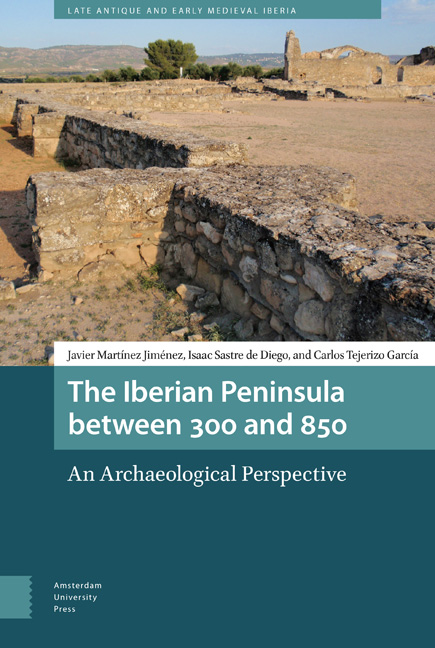Book contents
- Frontmatter
- Contents
- List of Figures
- Acknowledgements
- Preliminary notes
- Preface
- Introduction: An archaeological perspective on the Iberian peninsula between Rome and the Middle Ages
- Part 1 The Late Roman period
- Part 2 The post-Roman period
- Part 3 The Early Middle Ages
- Appendix 1 Site reference table
- Appendix 2 Maps
- Appendix 3 Lists of rulers
- Abbreviations
- Bibliography
- Index
5 - Towns and cities under Christian prevalence
Published online by Cambridge University Press: 10 December 2020
- Frontmatter
- Contents
- List of Figures
- Acknowledgements
- Preliminary notes
- Preface
- Introduction: An archaeological perspective on the Iberian peninsula between Rome and the Middle Ages
- Part 1 The Late Roman period
- Part 2 The post-Roman period
- Part 3 The Early Middle Ages
- Appendix 1 Site reference table
- Appendix 2 Maps
- Appendix 3 Lists of rulers
- Abbreviations
- Bibliography
- Index
Summary
The late Roman town, with its urbanism defined by the changes of the fourth century, continued to evolve along the same lines as described in previous chapters. However, following the barbarian invasions, there was an increase of new monumentality and of new constructions. This occurred in two different waves: firstly, during the late fifth century in those Roman towns which had become bishoprics (such as Mérida, Tarragona and Terrasa, among others); later, during the late sixth century, another input developed in the new capitals and urban foundations (above all Toledo, Reccopolis, El Tolmo and Cartagena), which emerged quickly together with other Roman centres of power. This was a consequence of both the development of new, stronger states (as happened in the Visigothic and Suevic kingdoms and in the Byzantine province) and of the consolidation of bishops as the new urban leaders in this new and fragmentary political framework.
In archaeological terms, the development of towns in the post-Roman period is both the story of the creation of a properly Christian, Late Antique urbanism and (to a lesser extent) the creation of a ‘post-Roman’ type of town. Both processes of transformation from the early Roman pagan model were, however, clearly and evidently conditioned by the late Roman urbanism that had developed in earlier centuries. In this chapter we will explore the nature of this new post-Roman urbanism, from three perspectives: firstly, we will look briefly at the state of towns at the beginning of the post-Roman period, before moving on to explore the new ecclesiastical monumentality; finally we will look at the urban changes prompted by the political developments of the late sixth century.
The late Roman urban legacy in the post-Roman world
Fifth-century urbanism is characterized by the appearance of the first episcopal complexes, which from the second half of the century had a great impact on towns. Nevertheless, there were no new architectural developments worth highlighting in these constructions, other than the continuation of the long-term processes of urban and technological change which had begun in the late Roman period – processes that would continue to develop through the sixth and seventh centuries. Urbanism slowly continued to evolve, but without the restrictions (or impetus) of the late Roman political system.
- Type
- Chapter
- Information
- The Iberian Peninsula between 300 and 850An Archaeological Perspective, pp. 153 - 192Publisher: Amsterdam University PressPrint publication year: 2018



